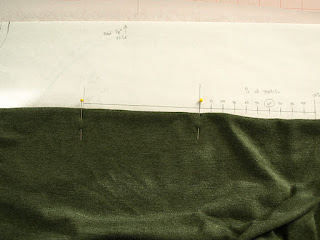Showing posts with label Knit fabrics. Show all posts
Showing posts with label Knit fabrics. Show all posts
December 15, 2011
T-shirt pattern quest pt. 2 : Calculating the amount stretch in a knit fabric
Patterns for styles made out of a knit fabric need to include the amount of wearing ease for the desired fit. In some cases the wearing ease is actually negative ease. Negative ease means the pattern measurement is smaller than the actual corresponding body measurement. A good example of this would be yoga pants in which the pants stretch to fit a particular size. In some cases the pattern has positive wearing ease because the style is larger than the corresponding body measurements, such as an oversized sweatshirt. Determining how much to reduce a pattern for a desired type of fit requires first determining a knit fabrics stretch factor.
Note - My pattern is intended for knits that have already been pre-washed and shrunk from retail store knits. So no extra allowance is included for shrinkage.
At this point I needed to check the amount of stretch in this fabric. Fold the fabric so that you are not testing on the edge of the fabric. Place two pins 5 inches apart.
Pick up the fabric and hold the left pin in your left hand at the zero mark and then stretch the fabric as far as it will go with your right hand. Watch where the right pin stretches on the stretch ruler. In this case, my fabric stretches about 30%. Only stretch the fabric as far as it will reasonably go without overly stressing the fabric.
Let go of the fabric with your right hand and watch to see if the fabric returns to it's original position. Knits that do not return at all, have no recovery. In this case, my fabric returned to the 10% mark, which isn't great, but probably ok for a top.
I had forgotten, but this particular fabric is an interlock rather than a jersey. Interlocks do not stretch nearly as much as a jersey. I had originally planned on adding about 1 inch of extra wearing ease because I wanted a bit looser fit. Now I wonder if I should add a bit of extra? Once I work that out, I will modify my pattern and cut it out.
January 07, 2009
Accounting for shrinkage and/or stretch in sewing patterns
Just a few comments I made in the Fashion Incubator forum when making patterns to accommodate stretch (knits, stretch wovens) and/or shrinkage.
Have to be careful when scaling patterns in CAD. Shrinkage/stretch is not proportionally the same in both directions. Many pattern making books advise to add the same amount of change to the length as the width. Don't do this. The only way to know is to know the fabric. Things shrink more in length than width. I am so sick of washing pants and long sleeve shirts and having them end up too short. If anything, remove width ease and add length on knits. It sounds counter-intuitive but prevents high-waters. Not sure on stretch denims, so test, test, test.In my Etsy shop I have a simple tech pack kit that includes a wash testing form. The wash testing form includes instructions and formulas to figure out shrinkage in both the length and width of a fabric. It is well worth the investment of time and money to test your fabrics for shrinkage, particularly knit fabrics. Once you know the approximate shrinkage of a knit fabric, I recommend adding the extra width and length needed to accommodate expected shrinkage.
Adding a shrinkage allowance to a pattern piece may cause the finished garment to look proportionally wrong. If you do not pre-wash the finished item before shipping to the retailer, the item may look wrong on the hanger and the customer may decline purchasing the item because it does not appear to fit. So there is a limit to the amount of shrinkage you can include in a pattern before proportions, fit, and hanger appeal are impacted. Generally, you can include about 3-5% shrinkage in a pattern without too much of an impact. If your wash testing results return a shrinkage greater than 5%, then you either need to reject the fabric or pre-shrink the fabric before cutting and sewing.
Knits in particular add an added layer to product development because they are more likely to shrink. There are various types of knit fabrics with different types of finishing. Some knits are pre-shrunk at the factory and some are not depending on whether the fabric will be printed or dyed at a later date. When sourcing knits it is important to ask about shrinkage.
Accounting for stretch in knit fabrics is also another added layer. Stretch influences fit. Should the item fit close to the body? If so, the pattern needs to be reduced in width and length. This is another area where the amount to reduce will be different for the length and width. As an item is stretched in one direction, the other direction also changes. You may notice this when you stretch a knit t-shirt in the width direction - the length of the t-shirt will shorten. This is a complex topic and the answers depend entirely on the style and chosen fabric.
Labels:
Fit,
Hanger appeal,
Knit fabrics,
Patternmaking,
Product development,
Quality,
Shrinkage,
Sizing,
Stretch,
Testing,
Wash testing
Subscribe to:
Posts (Atom)



